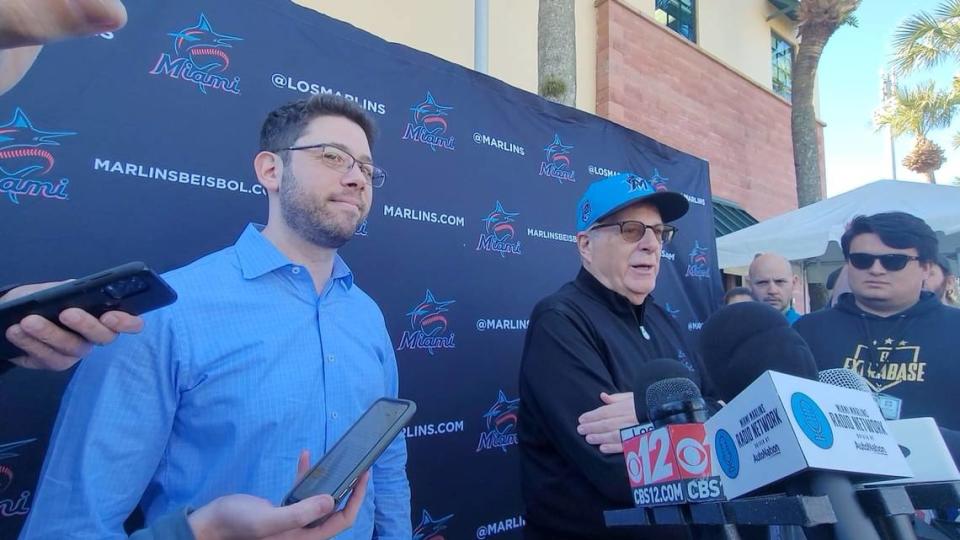Marlins mull options with 16th pick in Sunday’s Draft. Where things stand, who’s on radar

What do you get a Major League Baseball team that needs everything?
With the second-worst record in baseball and the second-worst farm system in the sport (according to MLB.com), the Marlins enter the 20-round MLB Draft knowing that virtually any position addressed could ultimately fill a need.
“We need everything,” new Marlins amateur scouting director Frankie Piliere said in a conversation with two reporters on Thursday, in advance of the Marlins’ selecting 16th overall on Sunday night. “We are looking three, four, five years down the road. If you keep stacking talent in all forms, you usually end up in a pretty good” place.
According to a source, there is sentiment inside the Marlins toward taking a hitter at No. 16, with some preferring a college hitter. But if a pitcher the Marlins really like falls to their range, that could change.
Several mock drafts have Miami picking a hitter in the first round.
Among those on their radar, according to sources: Florida State third baseman Cam Smith and Wake Forest shortstop Seaver King.
Smith is a popular Marlins projection in mock drafts. The Athletic’s Keith Law, a longtime evaluator, has Miami choosing Smith, who had a .387 average, a .488 on-base average, 16 homers and 57 RBI in 66 games for the Seminoles last season.
As a third baseman, he’s considered a better defender than former Marlins first-round pick Jacob Berry and more of an advanced hitter. But it remains to be seen if he will play third base or first base as a professional.
“The new regime in Miami will probably take a very different approach in the draft, and teams around them believe they’ll go college, and whichever way they go it will be model-heavy,” Law said.
Law said FSU outfielder James Tibbs (28 homers in 66 games last season) and Kentucky outfielder Ryan Waldschmidt (.333, 14 homers, 46 RBI in 59 games) would “all fit” the Marlins’ model.
Law said: “I’ve also heard speedy [Wauchula, Florida-based] high school [outfield] prospect Kellon Lindsey has one or two possible landing spots in the teens and I suspect the Marlins are one.”
Wake Forest’s King is another player that the Marlins have considered. He’s a stronger defender at shortstop, with a polished bat, but there isn’t a strong track record for hitters at Wake Forest having a lot of success. He batted .308, with a .377 on-base average, with 16 homers and 64 RBI in 60 games last season.
Piliere — who replaced dismissed DJ Svihlik with the Marlins — said the approach in Round 1 will be the best available player, regardless of position.
“We are looking at layers of impact talent wherever that comes in,” said Piliere, who previously worked six years for the Seattle Mariners. “One of the strengths of this class is this is a very strong college class. We have a class [with] very strong college hitters. But that won’t determine our strategy. We are considering everything.”
He said it’s “very highly likely that” whoever is selected by the Marlins will have spoken to team officials during the past weeks or months. Piliere and Marlins president/baseball operations Peter Bendix believe it’s important that any player selected high in the draft has been evaluated by several Marlins officials.
“We believe strongly in layers of looks,” Piliere said. “Multiple opinions are going to get us better decisions. We like to get as many opinions as possible. If that’s four or five, that’s a good bar to hit. Video is a big part of our process.
“It’s a year’s long process. We are learning about who they are as a person, how well they fit. We need to know a lot about these people and how ready they are to do this.”
How much emphasis do the Marlins place on a player being big-league ready? Piliere downplayed that. “The player will tell us when they’re ready,” he said.
ESPN draft analyst Kiley McDaniel is eager to see the Marlins’ approach in this new regime.
“I think bringing in [assistant general manager] Gabe Kapler overseeing all of the new people in player development, I think that’s more of the problem that needed to be solved that had been an issue for a long time there, and I think it’s on the road to being solved,” McDaniel said.
“I’m very curious to see who Frankie and Peter and Kapler and all those guys pick this year because that will say something about who they think they’re good at developing.
“I think they’re looking to get one of the players in that second tier [at No. 16]. I think like sort of [Tennessee second baseman] Christian Moore, [Wake Forest first baseman] Nick Kurtz, [East Carolina pitcher] Trey Yesavage, maybe Seaver King. I think it gets a little iffier at that point. I think they’re looking at the college bats, if they get there, that sort of aren’t supposed to get there.
“Otherwise, I think they’re looking at high school players with their next picks. Let’s undercut a high school guy that should go seven picks after us, get some savings and then go over the next couple picks with some high school hitters. I think that’s really what they want to do. And also Frankie coming from Seattle, that’s kind of what they did there.”
Among the players mentioned by McDaniel, Law has Kurtz going fourth, Yesavage 10th and Moore 14th, two spots before Miami’s selection. Moore hit .375 (.451 on-base average) with 34 homers and 74 RBI in 72 games for the Volunteers last season.
The first two rounds of the MLB Draft will be held on Sunday night, with Rounds 3 through 10 on Monday and 11 through 20 on Tuesday.

 Yahoo Sports
Yahoo Sports 
